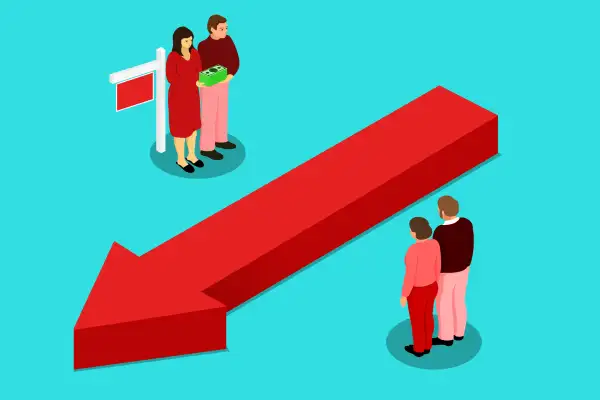Homebuyers and Sellers Alike Are Loving This Popular Trick to Lower Mortgage Rates

When Keagan and Derek Schmidt applied for their mortgage in September, they were quoted a 7% interest rate. By the time they closed on their Shakopee, Minnesota, home last month, their rate was down to 5.75%, reducing their monthly payment by more than $400.
How’d they do it? It was simple, really: They asked the seller for help.
“We actually negotiated with the sellers to do a $9,000 rate buydown,” Keagan says.
It might sound hard to believe given the red-hot seller’s market we saw just months ago, but buydowns are real — and surprisingly common.
“The buydown is extremely popular right now,” says Andrew Russell, owner of RCG Mortgage in Hauppauge, New York. “They went from non-existent to becoming more and more prevalent.”
As 7%-plus mortgage rates eat into affordability and push buyers out of the market, sellers are having to negotiate more. Often, that includes throwing in cash to reduce the buyer’s interest rate — either temporarily or for the entire loan term.
To be clear: It’s not just sellers who can chip in for buydowns. Buyers have long used this strategy — typically called “buying points” — to lower their own interest rates. Sellers, builders, lenders and even real estate agents can contribute toward buydowns, as well.
While there aren’t official numbers on this practice, anecdotally, agents and mortgage professionals say they’re seeing third-party-funded buydowns in anywhere from 10% to 50% of their deals. How does this strategy actually work, though? And what can you do to get one on your new mortgage? Here’s what buyers need to know.
Types of mortgage rate buydowns
Permanent rate buydowns
Mortgage rate buydowns are essentially a compromise with your lender. Rather than profiting off a higher interest rate for many years, the lender instead gets an upfront payment. Think of it like prepaid interest.
“Most lenders are compensated through some combination of fees they charge to a borrower and the backend premium they make on the interest rate,” says Jerimiah Taylor, vice president of real estate and mortgage at OJO Labs in Austin, Texas. “When a borrower pays more of the lender's compensation out of pocket, it allows the lender to sell the borrower a lower rate.”
Rate buydowns can be temporary, lasting just a few years, or permanent, as in the Schmidts’ case. With the latter, you get a reduced rate and monthly payment for your entire loan term — or until you sell or refinance.
In the mortgage world, permanent buydowns are most often called “buying points.” You (or another party) will pay an upfront fee to reduce your interest rate incrementally — typically between 0.125 to 0.50 percentage points. The exact price for this varies, but it’s usually anywhere from 0.375% to 1% of the total loan balance.
“The cost of a rate buydown is not one-size-fits-all,” says Scott Haymore, head of mortgage pricing and secondary markets at TD Bank. “It varies from originator to originator, and it’s also driven by product selection, market factors and end-investor guidelines.”
From a cash flow standpoint, permanent buydowns can be helpful. They can also make it easier to qualify for a loan or even expand your budget, according to Al Murad, executive vice president of AmeriSave Mortgage Corp.
“With the rise in interest rates over the past several months, rate buydowns have become an increasingly popular way for buyers to regain buying power,” Murad says.
Here’s an example: If you knew you could spend $1,500 per month and were quoted a 7% rate, that puts you at a maximum purchase price of $225,000. If you were able to get your rate down to 6.25%, though, it would increase your budget by nearly $20,000.
Temporary rate buydowns
There are also temporary rate buydowns, which give buyers a lower rate for the first few years of the loan, and then revert to the original quoted rate.
With this approach, the seller contributes a lump sum at closing, which is put in the buyer’s escrow account. Those funds are used to cover a portion of the buyer’s mortgage payments for up to three years.
“The lender is still charging the same rate,” says Jeremy Drobeck, senior loan originator at Amerifirst Home Mortgage in Kalamazoo, Michigan. “It's just coming from a different source — part of it's being paid by the seller and part of it by the buyer.”
There are many versions of temporary buydowns. Right now, pros say, the 2/1 buydown is most prevalent.
“The 2/1 buydown allows the consumer to have a rate 2% lower the first year of the loan and a 1% less for the second year,” says David Hosterman, regional manager at Citywide Home Loans in Greenwood Village, Colorado.
Once the loan hits the third year — and for every year beyond — the borrower will pay the original rate and payment they were quoted for.
That last part is critical, because on temporary buydowns, you’ll need to qualify for your loan based on that final rate and payment — not the reduced one.
“It’s important that you can comfortably afford the higher rate, as the lower rate is for a short period of time,” says Jennifer Beeston, senior vice president of mortgage lending at Guaranteed Rate Mortgage. “I’d look at a permanent buydown as the first option. Make sure you are working with a lender who digs into the math on both options with you so you can make an informed decision.”
How to use a mortgage rate buydown successfully
So, you want a lower mortgage rate. How exactly do you get the seller (or another party) to foot the bill? First, talk to your lender. Depending on the type of loan you’re using, there may be rules as to who can pay for a buydown and how much they can contribute.
“The key is to work with your mortgage lender upfront,” Taylor says. “Every loan program is going to have some sort of limit.”
Next, let your real estate agent know you’ll need a rate buydown to deal with today’s higher rates. Unless a seller or listing agent explicitly offers one up front, your agent will need to include the proposed seller concession in any offers you submit.
“Generally speaking, a seller concession is negotiated upfront, and the amount is strategically considered based on each individual client and their specific needs,” says Trudy Kelly, a senior loan officer at Churchill Mortgage in Portland. “I work very closely with the buyer’s agent once they find a home. We talk about how much the buyer needs to make the purchase work for them and how the home is priced for our current market to decide if there is room to ask for a seller credit.”
Take a recent transaction Kelly worked on. In this case, the seller agreed to a $15,000 buydown, which reduced the buyer’s rate by a full percentage point and her monthly payment by $341 for the entire loan term. Had the buyer simply offered less for the house, it would’ve meant a $30,000 price cut to achieve those kinds of monthly savings.
“What’s more important — what you pay for the home or what your monthly payment actually is?” Kelly asks. “Everyone won. We’ve been more aggressive with this tactic over the last few months — with noticeable results. I think you’ll see it become even more prominent as interest rates tick up.”
More from Money:
7 Common Home Buying Mistakes and How to Avoid Them
The Housing Market Is Shifting Almost Everywhere — But Are We in a Buyer's Market Yet?

